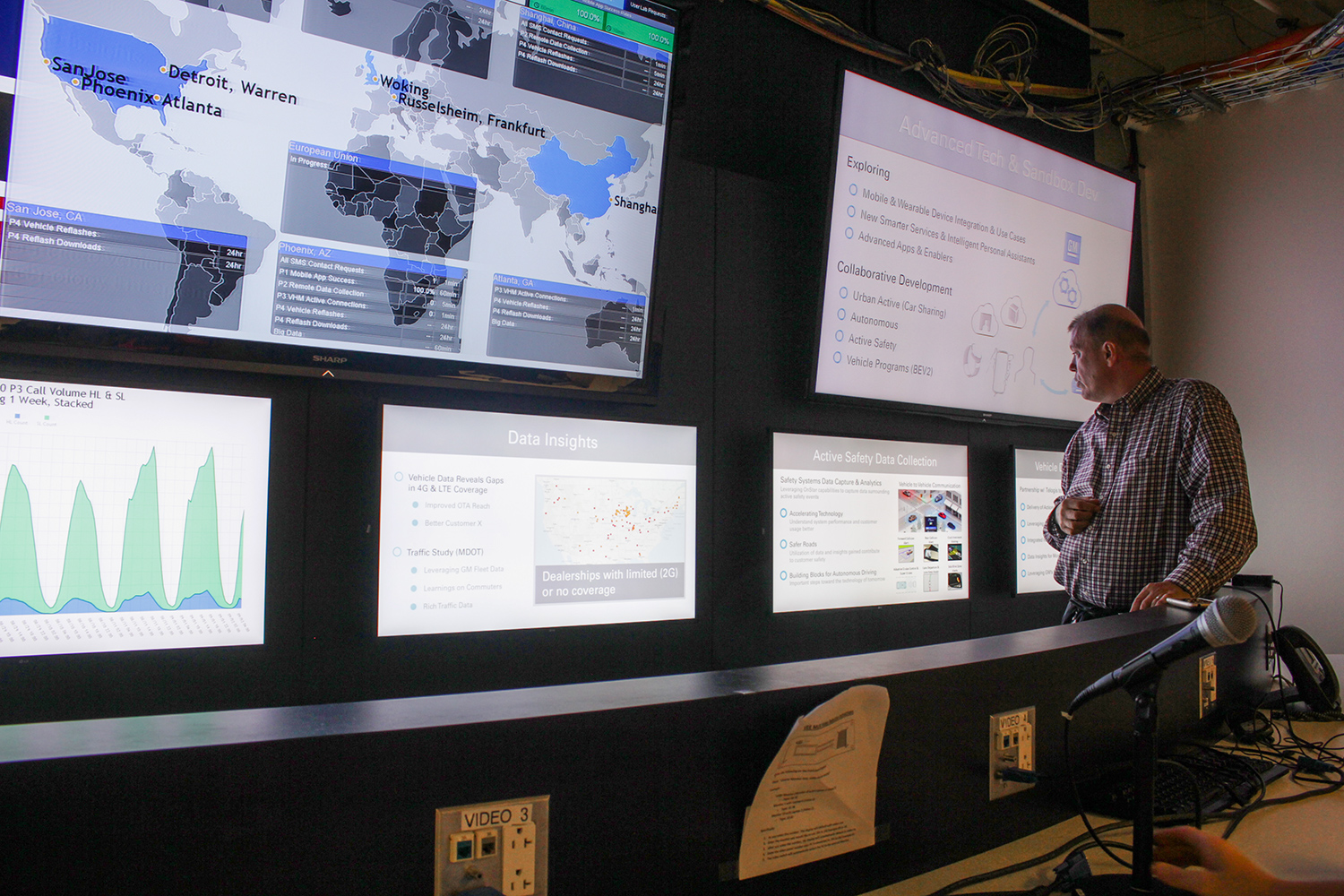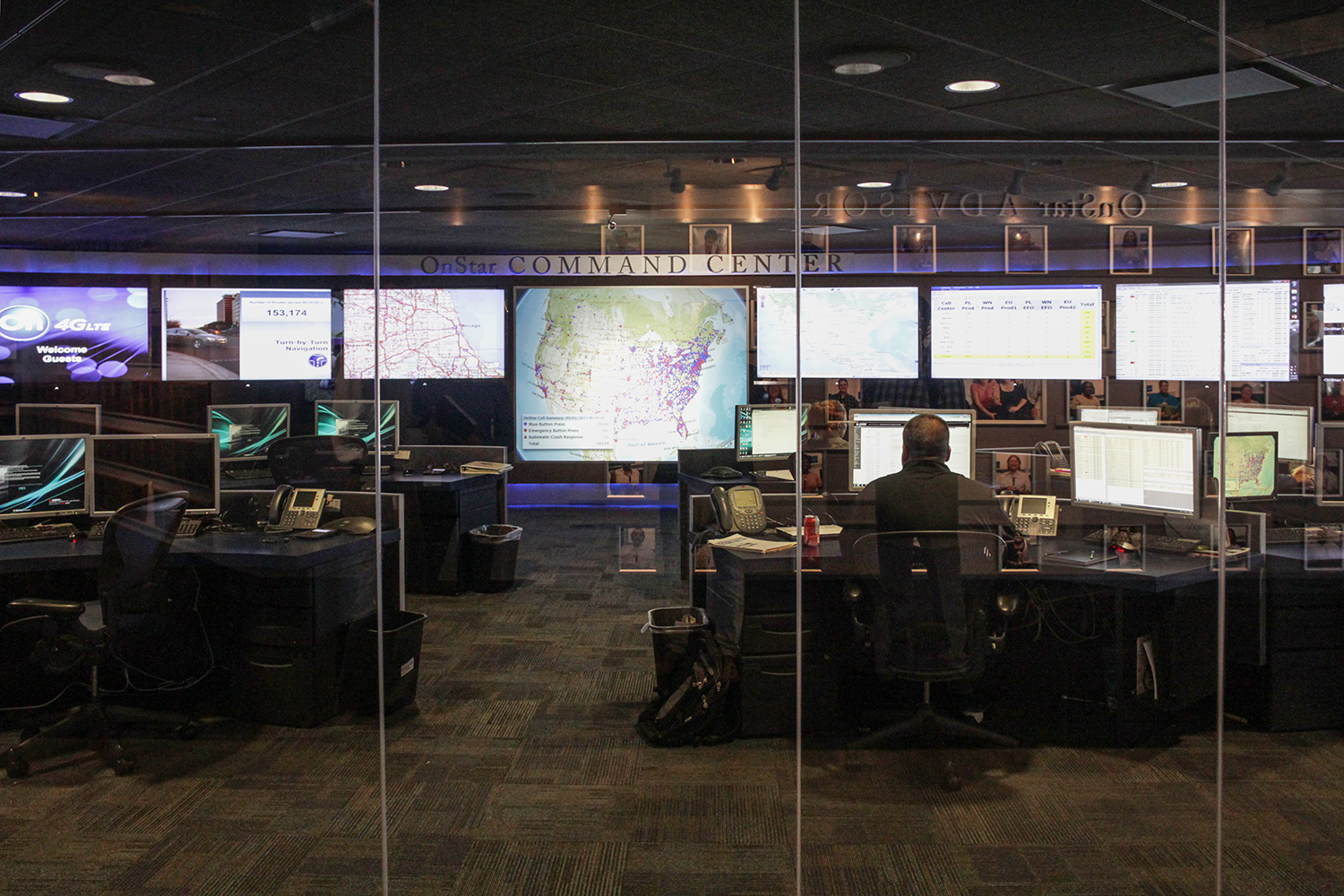
“I’m the chief infotainment officer for General Motors, and I’m full of self-loathing because I hate the word infotainment.”
So begins GM’s Phil Abram, the man responsible for improving the most important systems in our cars, the in-dash devices that steer us to our vacation homes, help us find the latest from Carly Rae Jepson or Johnny Rotten, and — by taking cellphones out of drivers’ hands — even save us from ourselves.
It’s an incredibly important role, but not one car companies have done particularly well with. Fixing systems many describe as “simply terrible” seems quite daunting, but with any luck Phil can help here, for one really good reason:
“I’m not a car guy,” the car-company executive says.
“Until the transporters from Star Trek become realized, you’re going to need a car.”
I’m sitting on the 39th floor of GM’s world headquarters, the Renaissance Center complex in downtown Detroit, in Abram’s office, and he doesn’t even look sheepish making that admission. Abrams is a tech guy, an engineer in fact. You might know his name from a little company he was president of called Sonos, or from stints at Sony, Sharp, and Eastman Kodak, where he built a portfolio of patents.
The million dollar question: Can technology save the car industry?
“I like Marc Andreessen, and while I don’t agree with everything he says, I think there’s some general trends — when he wrote that “Software Eats the World” article? Software isn’t going to eat the car industry, but it’ll take a big bite out of our ass if we allow it to,” he told me.
As it embraces technology, slowly and awkwardly, the auto industry should take to heart the examples seen in Kodak and Sony — companies that failed to adapt as the market changed around them, and were chewed up and spat out as a result. Sony (and every audio company) missed the transition to digital audio, for example. Abrams could have helped. During his time at the Japanese giant, Abram had a patent from 1997 on how to connect MiniDisc players to computers. The CEO at the time, Norio Ohga, found out about the project and canned it, Abram explains.
“He thought it would enable piracy.” Sorry. A little late for that one.
Kodak had similar problems making the transition from film to digital: One day Kodak was synonymous with “camera,” the next it was filing for bankruptcy.
“Eat your own or be eaten,” Abram said. “Kodak knew that it had to eat its own and it didn’t have the wherewithal and intestinal fortitude to do that.”
Does GM have a stronger stomach?
Why modern infotainment systems suck
Car companies spent years going it alone, building their own software systems that consumers generally didn’t like. Ask any driver what he thinks of his system and he’ll tell you he tolerates it, barely. What gives?
Almost every car on the road today has a system programmed and controlled in-house — Toyota’s Entune, VW’s RNS, Mazda’s Connect, and so on. For an obvious reason: The legal ramifications of glitches are astronomical. Yet here come companies like Apple and Google, eager to supplant years of development, and offering an arguably better system. Thing is, dashboards are very different devices.
“It should be non-engrossing, it should be enabling and freeing.”
“Until you radically change the car-driving responsibilities, there’s limitations to what you can do with the interface and how radically it can change,” Abram explains. “Whatever task you do has to be completed in under 12 seconds with only two-second, eyes-off-road glances to complete the task. That is, compared to a smartphone, an incredibly limiting set of conditions to apply.”
“Now you can innovate like hell within those boundaries, but with a smartphone there is no boundary other than the physical limitation of the screen size.”
Besides that, he notes, smartphones are designed to captivate us, to engross us, to sell us on the experience of using them. People walking into fountains or telephone poles while using their smartphones? That’s a victory for phone makers. That’s exactly what they want.
“With an infotainment system, it’s the 180-degrees opposite of that. It should be non-engrossing, it should be enabling and freeing, you should get your thing done and get out quickly and gone.”
Making something that works within that space is a challenge of design. I think it’s one car makers haven’t done so well. Abrams begs to differ, bringing up a comparison between the Chevrolet MyLink (“I consider that an outstanding infotainment system”) and Cadillac’s Cue (“the poster child for being the red-headed stepchild beating post for infotainment systems”). I don’t know if it’s that bad, but it sure has its detractors. Abram is one of them.
“It’s overwrought. Its aspirations far exceed its abilities to deliver against those things. Its performance latency, complexity — it has stuff in it that was, someone thought it up so they put it in there,” he said.
Cue is far more capable, yet MyLink was far more successful. Power isn’t always the best end goal. Usability, ease of use, discoverability … these are the heart of a good system, he explained.
Leaving software to the big boys
The million dollar question, then, is can Google and Apple help? Are CarPlay and Android Auto that much better? The interfaces seem familiar, a solution to the problem of today’s wonky systems.
Presently, Android Auto feels stripped down in terms of core functionality, and it has some bugs, but I will say it has a decent selection of apps right off the bat. At any rate, the system is totally worth getting into, if only to ditch the kludgy system your car came with. Plus, it’s bound to get better over time thanks to future updates. Even if it isn’t perfect, Android Auto is going to stick around, so you might as well get hip to it now.

It was hard work to get them to where they are today, Abram said.
“If you look at the early demos of it, versus what they brought out, you’ll see a huge shift in both of them. Because they worked with us, and other car manufacturers. It migrated from where they thought it would be to where it is now, where it does four things pretty well: music, navigation, messaging, and phone calls.”
The systems let consumers take the familiar products that have fit so smoothly into their lifestyles into their cars relatively seamlessly. There’s still room for improvement, Abram noted. Siri and Google Voice, two areas both companies have spent much energy recently, have yet to adapt fully to autos.
SuperDrive is cruise control on steroids.
“Their near field is pretty good. Far field — in a noisy environment with the car going down the highway with the microphones in the headliners — it’s not as good. And so there’s a lot of work that needs to be done on that, that’s going to evolve. Some of it’s going to be getting [the interface] better … there’s still a lot of polishing to be done there.”
Almost every major automaker is working on self-driving cars; GM will have a technology called Super Cruise available next year that takes us closer to it. Super Cruise is cruise control on steroids: It combines adaptive cruise control, where the cars adjusts its speed to account for traffic conditions, with lane-keeping skills thanks to high-resolution mapping, and lets the car essentially pilot itself down the highway. Look ma, no hands!
In a world where cars drive themselves, aren’t voice assistants like Siri and Google Voice the new interface to your infotainment, rather than those crummy jog dials and buttons? Nope.
“When you get to fully autonomous, you probably won’t be talking to your car,” Abram said. “You’re going to say ‘take me there’ and that’s it. The experience is going to be radically unassociated with the vehicle.”
The Security Brouhaha
Abram has presided over the department during a rough period: the rise of the car hacker. Over the past few months, hackers have tussled with Teslas, remotely tunneled into the OnStar system, and hacked the infotainment systems in Jeeps. The potential is terrifying: Imagine driving down the highway only to have your steering column lock up and your car turn itself off.
Abram is quick to point out that all of these situations arose from curious researchers, rather than by malicious criminals — not one of the recently demonstrated flaws has affected a single car.
“The number of vehicles that have been hacked in the real world, that have had a real impact on customers is, best number I can come up with is zero.” The issue is a serious one, of course, but not something to lose sleep over. Yet. Still, GM takes it seriously, he said.
“We created a chief cyber security officer about a year and half ago. We’re the first ones in the industry to do so. We’ve had 18 years of connected vehicles without an incident.” Doing it in a timely fashion is the challenge, he noted. GM was lauded for patching the OnStar issue in 24 hours this summer. But it doesn’t always move so fast.
“When you get to fully autonomous, you probably won’t be talking to your car.”
A recent Wired report claims GM took five years to patch another OnStar issue. The issue wasn’t negligence or a failure of the system but a simple reality of the times: When the hack was first revealed, car companies weren’t equipped to fix hackable bugs in their software as modern technology companies do. Abrams believes the years of experience with the OnStar system is actually a plus in terms of cybersecurity.
“One of the benefits of having 18 years of connected vehicles is you’ve thought through a lot of these scenarios for a lot longer. And you’ve bumped up against them as you go along — “Ooh, we’ve gotta build that in. Ooh, we’ve gotta build that in, too.”
The risks presented by security flaws such as those making headlines this summer are negligible, he stressed, although nothing to be taken lightly. Still, cars are a part of daily life. Technology will advance.
“A car is a car. A car moves your stuff from here to there, and until the transporters from Star Trek become realized, you’re going to need a car. Something’s gotta move you from here to there. Now your interaction with it is going to go through a tremendous amount of change over the next … five years. Certainly it’s going to far outpace the change over the last 50 years in this industry. And that’s exciting, that’s a great place to be.”
I like to tell my friends, cars and electronics, it doesn’t get any cooler than that!”














